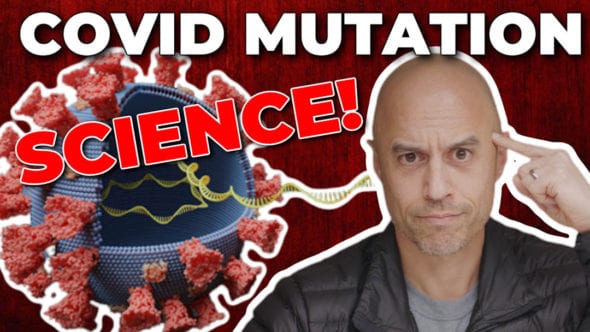How can we spin up a new vaccine platform so fast, and how could it be safe and effective? Time for some Science 101!
Here’s a nice summary piece.
Transcript Below!
Hey guys, Dr. Z. The other day I was talking to my Supporter Tribe doing a live show, and we were talking about mRNA vaccines. And I realized there’s a lot of confusion as to how these things work. We’re talking about the Moderna vaccine, the Pfizer vaccine, that are getting a lot of press because of their high efficacy in the early press release data. Now we need to look at the primary data, we need to look at the safety data, all of that. But, I wanna talk about, how do these vaccines work? Why might they be revolutionary for vaccines in general? How could they be spun up so quickly, and yet still be safe and effective? And so it starts with mRNA and how this whole thing works. So, when you look at regular, standard vaccines, there’s really a couple main ways that you can maybe three main ways you can create a vaccine. ‘Cause the goal is always, for all these vaccines. Is to stimulate your own immune system, to recognize a threat before that threat actually shows up. So, by exposing an immune system to a piece of a virus, right? What it does is the immune system can spin up a memory response, where when it’s exposed to the real thing in the future, it very quickly ramps up antibodies and T cells in this big immune response, and knocks that potential invader out of commission quickly. Whereas the first time you’re exposed to a virus, you have to start spinning up that immune response yourself for the first time and that can take days to weeks.
So, what the vaccines wanna do is expose your body to that invaders components that will trigger that immune response that will knock the invader out of action. And those are, classically we call them neutralizing antibodies, is one component of that. So, you wanna create these proteins, antibodies that bind to the part of the virus that will knock it out and neutralize it. Prevent it from entering your cells, allow the rest of the immune system to be activated and mop it up, and that’s what you wanna do. So the way it’s been done historically, is you can take the virus itself, you can grow it in culture, you can then kill it, and inactivate it and kind of mash it up, and then inject that in a purified way, into the body into… The intramuscular area, under the skin et cetera. And then what happens is the body is exposed to those particles, they’re not infectious ’cause it’s all killed and dead. You mount an immune response, the body remembers that immune response so the next time, when the real thing comes, it can quickly knock it out of commission.
The other way to do it is to actually take a virus, and make it less dangerous. So in other words, it’s somehow modified, attenuated is the term. So that it doesn’t cause actual disease, but it can still maybe even replicate, and therefore generate a pretty strong immune response, just like the real virus would without causing the disease. And a third way to do it is to actually purify a protein component of the virus and produce just that protein component. Inject the protein component, generate the immune response to that, et cetera, et cetera, et cetera. Now, those three ways take time. They’re the classic ways of doing it, because they’ve been studied for decades. It’s how we have most of our vaccines. For example, the chickenpox vaccine is a live attenuated vaccine, the influenza vaccine is a, the injected version, is a killed, inactivated virus. And so you have to spin them up. It can take six months for an influenza vaccine, a new version ’cause you gotta grow it in the culture, identify the virus, grown in the culture, purify it, get it at scale, get it into the vaccine and so on.
But, what did we do during COVID-19? Well, with Operation Warp Speed, and with all the work that’s been going on actually, over a decade on new vaccine technologies. And that’s what we’re gonna talk about right now, is mRNA. So how does this work and how is it faster? Alright. First we gotta talk about how this even happens in cells and what mRNA is and so on. Okay. We’ve all heard of DNA. Deoxyribonucleic acid. That is the genetic code that in a double stranded helix sits in the center of our cells in an organelle called the nucleus. It’s this little enclosed minicell within the cell. And that’s our sort of hard drive template for building more life for building proteins for building cells themselves. It’s encoded in that double stranded DNA and the way that that DNA is transcribed and translated into real life.
Meaning literally life, is through a compound called RNA. Ribonucleic acid. It’s slightly different than DNA. There’s one different base pair, you don’t need to know all that. What you do need to know is, it’s a different molecule but kind of related. And messenger RNA is a version of that that is basically transcribed by a special molecular apparatus, from the DNA into a strand of something called messenger RNA. And they call it messenger RNA because it is literally a messenger. It takes the information from DNA, encodes it in this single strand of messenger RNA, and that mRNA can pass through the nucleus into the main part of the cell called the cytoplasm. That’s all that goo in the center of the cell. And in the cytoplasm, there are these special, little, manufacturing protein units called ribosomes. And what the ribosomes do is they read the mRNA strand, and they translate it into actual proteins. So each of these little base pairs within the mRNA gets correlated to a particular amino acid, and the amino acids then it reads this thing like a little piece of ticker tape. This ribosomal protein. And the mRNA passes through and amino acids get attached through a complex mechanism we don’t need to get into. And they start to chain up into a strand. And that’s encoded for, in your DNA through the mRNA. And it then tells the ribosome what protein to make. So this big strand of amino acids happens and the beautiful thing about amino acids is they have chemical structures, the way they interact with water and all of that, that when they form a strand, they will naturally fold into a configuration that forms their end protein. And how that folds that structure of that protein determines its function and its activity in the cell. And outside of the cell. And in life in general.
It’s really, it’ll give you goosebumps, how beautiful nature actually is. So, how can we hack nature? That’s what we wanna do with vaccines. We wanna say, “okay, nature is beautiful, “let’s learn from it, “and adapt to it “and actually use what we’ve learned “to actually improve the flourishing of human beings.” Right? So the way you do that with mRNA, is you say, “Okay, well, we wanna make a vaccine, “quickly, “safely, “and effectively.” Well, what do we know about the SARS coronavirus 2? We know that it has these proteins on the surface of it called spike proteins. Now, the spike protein is the business end of this virus when it comes to infection because, it may be the means by which the virus enters human cells through something called the ACE2 receptor. yada, yada, yada, yada, yada. So what does that mean? It means that the spike protein early on was identified because we had experience with SARS the original, and MERS and related coronaviruses like that. That that spike protein is the key to getting in cells. So, if we create antibodies against that protein, you would block it and therefore disable the virus from entering cells, and allow the immune system to mop it up. In theory, right?
So, they said, “Well, okay, how about this? “How about, “we create mRNA.” And this is an advantage of mRNA. With the other viral vaccines, you have to grow the virus in culture. It takes time. And sometimes it’s grown in egg, sometimes it’s grown in cell lines, and all this stuff. It takes time and then you have to purify it to a medical grade purity. And this is a lot. It takes time, it takes work, it takes, and there’s a lot of steps that can go wrong. With mRNA, it’s synthesized because messenger RNA is a chemical. You can synthesize it. You don’t necessarily need to do it biologically. So that means that you can create this mRNA in a manufacturing process quickly. They’re short little simple molecules, and you can tell that mRNA, because we have the genetic code. We don’t even need the original virus.
When the Chinese discovered the virus and sequenced it, all you had to do is look at the sequence. And you could see Oh, there’s the spike protein ’cause it looks just like SARS the first one, okay. Now I can create an mRNA based on just the code that I’ve been given. Because RNA is just a code. So, you can make this little piece of mRNA that encodes for the very simple spike protein. Get it into cells. Your own human cells start making this viral protein which by itself, the protein doesn’t cause harm because it’s not infectious. It’s just the outer layer of the virus. It doesn’t have the ability to replicate, it doesn’t have DNA or RNA itself, it’s not a full virus, it’s just this little protein. That protein can then trigger our immune response because the body will recognize it as foreign, and it’ll trigger all the immune response that a regular infection would trigger or a, uh mm, uh mm a vaccine that would just give you that protein through viral inactivated virus would do.
So, it’s very it theoretically sounds great, right? Well, what’s the what’s the difficulty? There’s always a catch. Why don’t we have tons of mRNA vaccines? Why would these if they become FDA approved, be the first ever mRNA FDA approved vaccines for humans? Even though we’ve been working on it for since in 2005, was some seminal work. It’s been over a decade. Well, the reason is mRNA is a tricky molecule. Couple things. One, it’s innately unstable. Meaning it degrades very rapidly. And you would want this because if you’re transcribing DNA from the nucleus, and you’re spitting out mRNA, and it gets into the cell into the cytoplasm of the cell, you want it to do its business and then fall apart. You don’t want it to hang around forever or you’re gonna get a butt-ton of protein. Maybe more than you want, right? So that’s one issue. So it degrades very quickly. And what you’re doing with vaccines is you’re injecting them intramuscular. So it’s getting around the muscle cells, and it just gets broken down. Doesn’t last very long. The other problem is it’s not gonna produce a lot of protein, because it’s breaking down so fast. So you won’t get enough of that viral spike protein made to generate an immune response. The third problem is human immune system does not like foreign RNA or DNA. Especially RNA. For some reason, human cells, and it makes perfect sense. You have foreign viruses that degrade and release their RNA outside cells, triggers an immune response. An inflammatory immune response. So you can imagine, that that RNA is going to trigger inflammation and is gonna get broken down. The mRNA. So that’s a problem. So how do you get around that? And the other issue is getting it into the cells.
Now how do you get that mRNA into the cells? Doesn’t just easily cross the cell membrane. ‘Cause the cell membrane as you remember from high school biology or maybe you don’t. Is this really fascinating thing. It’s really what allowed life to happen because you have the inside of the cell separated from the outside of the cell. Which is a tremendous advance in everything. And the way that that happened is something called a phospholipid bilayer. Which, this is kind of fun. If you’ve ever used detergent, it kind of works in this way. Some chemicals love water. We call them hydrophilic. Like vinegar and water just mix, right? Like dissolves like. Some chemicals love fats and lipids, which are fats. And so we call those hydrophobic. They don’t get along with water very well. Turns out a cell membrane has a lipid bilayer, phospholipid bilayer, that’s both. It is amphiphilic. Meaning it loves both of them, but in different ways. So, a liquid bilayer has a head, like a little sperm. It almost looks like a head and a tail. The head loves water. So it faces the outside of the cell. The tail loves fat. So it tries to get away from that water. But there’s more water inside of the cell. So what do you do? Another little sperm and tail. So you got the sperm, the tail, the sperm, the tail. And the membrane is formed by the two heads which love water and face inside and outside the cell. And then the two tails. Which are hydrophobic, they are lipids. And they form that inner side. That is away from water. And together, they form this beautiful membrane.
Throughout the membrane are channels, and receptors, and gates that allow different compounds to selectively get through. So how’s that mRNA going to get through this barrier? Well, this was the big advance. In 2000… There’s two things. Two things that they advanced in. In 2005 they realized we could prevent the immune response and the inflammation to a large degree by using modified RNA. So RNA that has had been modified. As it often is modified in human cells. But not in bacterial and viral cells. And that may be part of the way that the immune system actually recognizes the difference. So you can use these modified nucleosides, which are the sub building blocks of RNA, and incorporate them into this mRNA. And then, body doesn’t break it down as fast, doesn’t reject it as fast, doesn’t generate as much of an inflammatory response. That was a huge breakthrough, 2005. Allowed paved the way to actually do a lot of the work in these mRNA vaccines that we are seeing now. So, that’s one thing.
But how about the rest of it getting into the cell, protecting it from more degradation? Ah, well turns out, take a cue from the cell membrane. Cell membrane is wrapped in this phospholipid bilayer. Well, what if we create these lipid nanoparticles. Which are basically a fatty little bubble, that puts the mRNA inside, has the fat on the outside, protects it from the water base in the arm that you’re injecting it to around the muscles and the extracellular fluid. And protects it and then also allows it more easily to merge with the cell membrane and deliver the RNA into the cytoplasm of the cell. Bingo! Well, that’s what they did. These lipid nanoparticles LNPS’s, are what encase the mRNA. In these vaccines. And allow them to enter the cell. Now remember, they never get into the nucleus. So this idea of like, it’s incorporating into our DNA, it doesn’t work that way with mRNA. Lives in the cytoplasm, turns out then you produce a lot of the protein, you get the immune response, and boom! 90 to 95% efficacy in the early data that’s coming out of these trials in 10s of thousands of people. Now, what’s fascinating is, there are some issues that arise with mRNA vaccines. That we’ve been hearing about. One is, you need to refrigerate them. Because they’re, again they’re delicate. They need really cold refrigeration whether it’s the lipid nanoparticle stability, or the mRNA, the modified mRNA itself. It needs to be very cold and once you thaw it you gotta use it within a few days or it’s not gonna work. So that’s one interesting thing.
The second thing is, these reports have pretty heavy duty inflammatory responses early on that are transient. By the way they go away, they’re not permanent. May have to do, with the immune system response to that mRNA, even though it’s been modified. It could be that. So it could be and that can be helpful. So there’s some speculation that part of the reason these are so effective is that they’re actually jazzing the immune response too. So you’re getting this very aggressive immune response that then is remembering that and when virus real virus comes along, SARS-CoV-2 comes along, it doesn’t have a chance, right? And, but you can also get negative inflammation effects like all the symptoms that you’re getting. And it could be that that’s why people get these fevers, and muscle aches, and headaches and stuff from the vaccine itself because it’s generating this really strong immune response. Which may be a good thing.
But it could also be that you’re getting an immune response to the lipid nanoparticle itself ‘Cause that’s also a foreign thing. So they don’t know entirely, but the truth is, you gotta look at safety data, go okay, so are you seeing any signs of other autoimmune difficulties that could result from that. And believe me, they are looking at that because that would be an obvious thing you’d wanna test for, right? You have enough people in these trials that you can do that. So, that being said, this is kind of how this whole thing works. mRNA, coding for the protein, get it into the cell using lipid nanoparticles, stabilize it through modification. It then produces more purified spike protein for that SARS-CoV-2 surface protein that you wanna produce neutralizing antibodies too. Those proteins are made, are presented on the cell, on the surface immune response happens. Immune response then is remembered. Real infection comes, and you’re good. We don’t know how long it lasts yet, so that’s still to be determined. But it seems pretty robust initially, we wanna look at all the data.
I’m not taking the vaccine until I’ve seen final data. And I’ve talked to experts who’ve either worked on it or who have looked at the data themselves directly. And once we know that, I’ll be the first to come on and say “hey, this is the thing to do.” or “you know what? “more data is needed”, right? And I think a lot of healthcare workers even are always like, “wait, wait, wait, wait, wait, wait, wait, “wait, wait, wait wait. “This is so fast. “How could it possibly be safe and effective?” And the answer is, it can possibly be safe and effective because mRNA is a completely different technology. Now again it’s new. So that makes people very scared and nervous. And I totally get that. Which is why you gotta, you gotta science, the crap out of it. Alright guys? I hope this was helpful. Please share the video. I love you guys. More on this coming soon. And we are out. Yo, did you think that was dope? Hey, become a subscriber. Click the subscribe button, then right to the right of this little bell, hit that bell. Boo yah! You get notifications. Never miss any of our stuff. I love you guys. We out.
Related Videos
Category
- The ZDoggMD Show (799)
- Featured Videos (188)
- Doc Vader (142)
- Against Medical Advice (128)
- Medical Humor (95)
- Public Service Announcements (87)
- Music Parodies (74)
- Nurses (59)
- Meditation (38)
- ZVlogg (36)
- The VPZD Show (31)
- ZTalks (28)
- ZBlogg (24)






